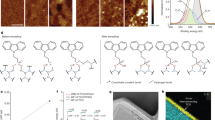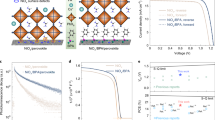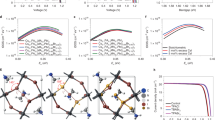Abstract
As the record single-junction efficiencies of perovskite solar cells now rival those of copper indium gallium selenide, cadmium telluride and multicrystalline silicon, they are becoming increasingly attractive for use in tandem solar cells due to their wide, tunable bandgap and solution processability. Previously, perovskite/silicon tandems were limited by significant parasitic absorption and poor environmental stability. Here, we improve the efficiency of monolithic, two-terminal, 1-cm2 perovskite/silicon tandems to 23.6% by combining an infrared-tuned silicon heterojunction bottom cell with the recently developed caesium formamidinium lead halide perovskite. This more-stable perovskite tolerates deposition of a tin oxide buffer layer via atomic layer deposition that prevents shunts, has negligible parasitic absorption, and allows for the sputter deposition of a transparent top electrode. Furthermore, the window layer doubles as a diffusion barrier, increasing the thermal and environmental stability to enable perovskite devices that withstand a 1,000-hour damp heat test at 85 ∘C and 85% relative humidity.
This is a preview of subscription content, access via your institution
Access options
Access Nature and 54 other Nature Portfolio journals
Get Nature+, our best-value online-access subscription
$29.99 / 30 days
cancel any time
Subscribe to this journal
Receive 12 digital issues and online access to articles
$119.00 per year
only $9.92 per issue
Buy this article
- Purchase on Springer Link
- Instant access to full article PDF
Prices may be subject to local taxes which are calculated during checkout



Similar content being viewed by others
References
Best Research-Cell Efficiencies (NREL, 2016); http://www.nrel.gov/ncpv/images/efficiency_chart.jpg
De Wolf, S. et al. Organometallic halide perovskites: sharp optical absorption edge and its relation to photovoltaic performance. J. Phys. Chem. Lett. 5, 1035–1039 (2014).
Stranks, S. D. et al. Electron–hole diffusion lengths exceeding 1 micrometer in an organometal trihalide perovskite absorber. Science 342, 341–344 (2014).
Brandt, R. E., Stevanović, V., Ginley, D. S. & Buonassisi, T. Identifying defect-tolerant semiconductors with high minority carrier lifetimes: beyond hybrid lead halide perovskites. MRS Commun. 5, 265–275 (2015).
Noh, J. H., Im, S. H., Heo, J. H., Mandal, T. N. & Seok, S. I. Chemical management for colorful, efficient, and stable inorganic-organic hybrid nanostructured solar cells. Nano Lett. 13, 1764–1769 (2013).
Bailie, C. D. et al. Semi-transparent perovskite solar cells for tandems with silicon and CIGS. Energy Environ. Sci. 8, 956–963 (2014).
Todorov, T., Gershon, T., Gunawan, O., Sturdevant, C. & Guha, S. Perovskite-kesterite monolithic tandem solar cells with high open-circuit voltage. Appl. Phys. Lett. 105, 173902 (2014).
Mailoa, J. P. et al. A 2-terminal perovskite/silicon multijunction solar cell enabled by a silicon tunnel junction. Appl. Phys. Lett. 106, 121105 (2015).
Löper, P. et al. Organic–inorganic halide perovskite/crystalline silicon four-terminal tandem solar cells. Phys. Chem. Chem. Phys. 17, 1619–1629 (2015).
Albrecht, S. et al. Monolithic perovskite/silicon-heterojunction tandem solar cells processed at low temperature. Energy Environ. Sci. 9, 81–88 (2016).
Werner, J. et al. Sputtered rear electrode with broadband transparency for perovskite solar cells. Sol. Energ. Mat. Sol. Cells 141, 407–413 (2015).
Kranz, L. et al. High-efficiency polycrystalline thin film tandem solar cells. J. Phys. Chem. Lett. 6, 2676–2681 (2015).
Yang, Y. M. et al. Multilayer transparent top electrode for solution processed perovskite/Cu(In,Ga)(Se,S)2 four terminal tandem solar cells. ACS Nano 9, 7714–7721 (2015).
Chen, B. et al. Efficient semitransparent perovskite solar cells for 23.0%-efficiency perovskite/silicon four-terminal tandem cells. Adv. Energy Mater. 6, 1601128 (2016).
Werner, J. et al. Efficient monolithic perovskite/silicon tandem solar cell with cell area >1 cm2. J. Phys. Chem. Lett. 7, 161–166 (2016).
Yang, Z. et al. Stable low-bandgap Pb-Sn binary perovskites for tandem solar cells. Adv. Mater. 28, 8990–8997 (2016).
Fu, F. et al. Low-temperature-processed efficient semi-transparent planar perovskite solar cells for bifacial and tandem applications. Nat. Commun. 6, 8932 (2015).
Eperon, G. E. et al. Perovskite-perovskite tandem photovoltaics with optimized bandgaps. Science 354, 861–865 (2016).
Lal, N. N., White, T. P. & Catchpole, K. R. Optics and light trapping for tandem solar cells on silicon. IEEE J. Photovolt. 4, 1380–1386 (2014).
Bailie, C. D. & McGehee, M. D. High-efficiency tandem perovskite solar cells. MRS Bull. 40, 681–686 (2015).
Ginley, D. S., Hosono, H. & Paine, D. C. Handbook of Transparent Conductors (Springer, 2011); http://dx.doi.org/10.1007/978-1-4419-1638-9
Liao, L. S. et al. Ion-beam-induced surface damages on tris-(8-hydroxyquinoline) aluminum. Appl. Phys. Lett. 75, 1619–1621 (1999).
Leijtens, T. et al. Stability of metal halide perovskite solar cells. Adv. Energy Mater. 5, 1500963 (2015).
Liu, P. et al. Interfacial electronic structure at the CH3NH3PbI3/MoOx interface. Appl. Phys. Lett. 106, 193903 (2015).
Yang, W. S. et al. High-performance photovoltaic perovskite layers fabricated through intramolecular exchange. Science 348, 1234–1237 (2015).
Lee, J. W. et al. Formamidinium and cesium hybridization for photo- and moisture-stable perovskite solar cell. Adv. Energy Mater. 5, 1501310 (2015).
Yi, C. et al. Entropic stabilization of mixed A-cation ABX 3 metal halide perovskites for high performance perovskite solar cells. Energy Environ. Sci. 9, 656–662 (2016).
Liu, X. et al. Spray reaction prepared FA1-xCsxPbI3 solid solution as light harvester for perovskite solar cells with improved humidity stability. RSC Adv. 6, 14792–14798 (2016).
McMeekin, D. P. et al. A mixed-cation lead mixed-halide perovskite absorber for tandem solar cells. Science 351, 151–155 (2016).
Saliba, M. et al. Cesium-containing triple cation perovskite solar cells: improved stability, reproducibility and high efficiency. Energy Environ. Sci. 9, 1989–1997 (2016).
Bakke, J. R., Pickrahn, K. L., Brennan, T. P. & Bent, S. F. Nanoengineering and interfacial engineering of photovoltaics by atomic layer deposition. Nanoscale 3, 3482–3508 (2011).
Palmstrom, A. F., Santra, P. K. & Bent, S. F. Atomic layer deposition in nanostructured photovoltaics: tuning optical, electronic and surface properties. Nanoscale 7, 12266–12283 (2015).
Kim, B.-J. et al. Highly efficient and bending durable perovskite solar cells: toward wearable power source. Energy Environ. Sci. 8, 916–921 (2015).
Baena, J. P. C. et al. Highly efficient planar perovskite solar cells through band alignment engineering. Energy Environ. Sci. 8, 2928–2934 (2015).
Zhu, Z. et al. Enhanced efficiency and stability of inverted perovskite solar cells using highly crystalline SnO2 nanocrystals as the robust electron-transporting layer. Adv. Mater. 28, 6478–6484 (2016).
You, J. et al. Improved air stability of perovskite solar cells via solution-processed metal oxide transport layers. Nat. Nanotech. 11, 75–81 (2016).
Kim, J. H. et al. High-performance and environmentally stable planar heterojunction perovskite solar cells based on a solution-processed copper-doped nickel oxide hole-transporting layer. Adv. Mater. 27, 695–701 (2015).
Bush, K. A. et al. Thermal and environmental stability of semi-transparent perovskite solar cells for tandems enabled by a solution-processed nanoparticle buffer layer and sputtered ITO electrode. Adv. Mater. 28, 3937–3943 (2016).
Mullings, M. N., Hägglund, C. & Bent, S. F. Tin oxide atomic layer deposition from tetrakis(dimethylamino)tin and water. J. Vac. Sci. Technol. A 31, 61503 (2013).
Guziewicz, E. et al. ALD grown zinc oxide with controllable electrical properties. Semicond. Sci. Technol. 27, 74011 (2012).
Despeisse, M. et al. Resistive interlayer for improved performance of thin film silicon solar cells on highly textured substrate. Appl. Phys. Lett. 96, 10–13 (2010).
Larson, B. W. et al. Thermal [6,6]- >[6,6] isomerization and decomposition of PCBM (phenyl-C61-butyric acid methyl ester). Chem. Mater. 26, 2361–2367 (2014).
Mullings, M. N. et al. Thin film characterization of zinc tin oxide deposited by thermal atomic layer deposition. Thin Solid Films 556, 186–194 (2014).
Hägglund, C. et al. Growth, intermixing, and surface phase formation for zinc tin oxide nanolaminates produced by atomic layer deposition. J. Vac. Sci. Technol. A 34, 21516 (2016).
Holman, Z. C. et al. Current losses at the front of silicon heterojunction solar cells. IEEE J. Photovolt. 2, 7–15 (2012).
Holman, Z. C. et al. Infrared light management in high-efficiency silicon heterojunction and rear-passivated solar cells. J. Appl. Phys. 113, 13107 (2013).
Holman, Z. C., De Wolf, S. & Ballif, C. Improving metal reflectors by suppressing surface plasmon polaritons: a priori calculation of the internal reflectance of a solar cell. Light Sci. Appl. 2, e106 (2013).
Holman, Z. C. & Kortshagen, U. R. A flexible method for depositing dense nanocrystal thin films: impaction of germanium nanocrystals. Nanotechnology 21, 335302 (2010).
Kim, I. S. & Martinson, A. B. F. Stabilizing hybrid perovskites against moisture and temperature via non-hydrolytic atomic layer deposited overlayers. J. Mater. Chem. A 3, 20092–20096 (2015).
Acknowledgements
The authors thank M. Leilaeioun and K. Fisher for assistance with silicon cell fabrication and simulation. The information, data and work presentedherein were funded in part by the US Department of Energy (DOE) Sunshot NextGen III program under award number DE-EE0006707, the National Science Foundation (NSF) and Department of Energy under NSF Cooperative Agreement No. EEC-1041895, the Research Corporation for Science Advancement through Scialog Collaborative Innovation Award Number 23460, and the National Research Foundation Singapore through the Singapore MIT Alliance for Research and Technology’s Low Energy Electronic Systems research programme. K.A.B. is supported by the NSF Graduate Research Fellowship Program under Grant No. DGE-114747. The optical measurements were performed in part at the Stanford Nanofabrication Facility’s nSiL laboratory, which is funded by NSF award ARI-0963061. AFM and SEM were performed at the Stanford Nano Shared Facilities (SNSF). We appreciate those who provided supplies for device encapsulation: J. Kapur (Dupont) for Surlyn, L. Postak (Quanex) for Solargain edge tape, T. Orfley (Corning) for eagle glass, and S. Ebers and S. Lee (Ulbrich Solar Technologies) for bus ribbon.
Author information
Authors and Affiliations
Contributions
K.A.B. led the fabrication of the perovskite solar cell; A.F.P. performed the ALD process for the window layer on the perovskite solar cell; Z.J.Y. led the fabrication of the silicon heterojunction solar cell; M.B. assisted with the fabrication of the silicon nanoparticle rear reflector. R.C. packaged devices. D.P.M. initiated the perovskite development. R.L.Z.H. developed the NiOx layer. C.D.B., J.P.M., T.L. and I.M.P. aided in project ideation and planning. M.C.M. assisted in semi-transparent-perovskite fabrication. N.R. performed AFM measurements. R.P. performed transfer-matrix optical modelling. S.S. assisted in ALD work. D.H. assisted in packaging and stability testing. W.M. and F.M. assisted in ITO deposition. K.A.B., A.F.P., Z.J.Y., Z.C.H. and M.D.M. wrote the manuscript, and all the rest discussed and reviewed the manuscript. Z.C.H. and M.D.M. led the entire project.
Corresponding authors
Ethics declarations
Competing interests
The authors declare no competing financial interests.
Supplementary information
Supplementary Information
Supplementary Tables 1–4, Supplementary Figures 1–11, Supplementary References. (PDF 1320 kb)
Rights and permissions
About this article
Cite this article
Bush, K., Palmstrom, A., Yu, Z. et al. 23.6%-efficient monolithic perovskite/silicon tandem solar cells with improved stability. Nat Energy 2, 17009 (2017). https://doi.org/10.1038/nenergy.2017.9
Received:
Accepted:
Published:
DOI: https://doi.org/10.1038/nenergy.2017.9
This article is cited by
-
Inhibition of halide oxidation and deprotonation of organic cations with dimethylammonium formate for air-processed p–i–n perovskite solar cells
Nature Energy (2024)
-
Perovskite/silicon tandem solar cells–compositions for improved stability and power conversion efficiency
Photochemical & Photobiological Sciences (2024)
-
Interfacial modification in perovskite-based tandem solar cells
Nano Convergence (2023)
-
Methylammonium-free wide-bandgap metal halide perovskites for tandem photovoltaics
Nature Reviews Materials (2023)
-
Polycrystalline silicon tunnelling recombination layers for high-efficiency perovskite/tunnel oxide passivating contact tandem solar cells
Nature Energy (2023)



